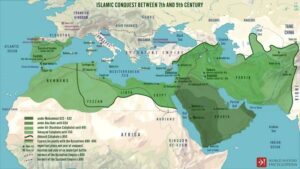
How Did Umar Conquer Bait al-Maqdis?
Discover the historical account of how Caliph Umar ibn al-Khattab peacefully conquered Bait al-Maqdis (Jerusalem) in 637 CE. The conquest of Bait al-Maqdis (Jerusalem) by Hazrat Umar ibn Al-Khattab (RA), the second Caliph of Islam, is a significant event in Islamic history. This conquest was marked by strategic military planning, diplomacy, and an emphasis on justice and religious tolerance. The peaceful transfer of power and Umar’s respectful treatment of the city’s inhabitants set a precedent for Islamic governance. This article delves into the details of how Umar ibn Al-Khattab conquered Bait al-Maqdis and the events surrounding this historic moment.

Background of Bait al-Maqdis:
Bait al-Maqdis, known in the Western world as Jerusalem, is a city of profound religious significance to Muslims, Christians, and Jews. It is home to Al-Aqsa Mosque, one of the holiest sites in Islam, as well as significant Christian and Jewish religious landmarks. During the early 7th century, the city was under the control of the Byzantine Empire, a Christian stronghold.
The Muslim Expansion
Following the death of the Prophet Muhammad (PBUH), the first Caliph, Abu Bakr (RA), initiated the expansion of the Islamic state. This expansion continued under the leadership of Umar ibn Al-Khattab, who succeeded Abu Bakr. The Muslim armies, under skilled commanders like Khalid ibn al-Walid and Amr ibn al-As, achieved significant victories against the Byzantine and Sassanian empires.
The Siege of Jerusalem:

In 636 CE, the decisive Battle of Yarmouk saw the Muslim forces defeating the Byzantine army, which significantly weakened Byzantine control over the Levant. Following this victory, Muslim forces turned their attention to Jerusalem. The city’s strategic and religious importance made it a key target for the expanding Islamic state. siege of Jerusalem: Click here
The Muslim army, led by commanders such as Abu Ubaidah ibn al-Jarrah and Khalid ibn al-Walid, laid siege to Jerusalem in 637 CE. The siege lasted for several months, with the Muslim forces encircling the city and cutting off supplies. Despite the prolonged siege, the Muslim commanders were instructed by Umar to avoid unnecessary bloodshed and to offer terms of surrender that ensured the safety and religious freedom of Jerusalem’s inhabitants.

The Peaceful Surrender:
The Byzantine patriarch of Jerusalem, Sophronius, agreed to surrender the city under the condition that the terms of surrender be personally negotiated with the Caliph Umar. Respecting this request, Umar traveled from Medina to Jerusalem. His journey was marked by humility and simplicity, traveling with only a few companions and sharing his mount with his servant.
Upon reaching Jerusalem, Umar met with Sophronius and other city leaders. The terms of the surrender were negotiated, ensuring the protection of Christian holy sites and the rights of the city’s inhabitants. This agreement is famously known as the “Pact of Umar.” The pact guaranteed that Christians could continue practicing their faith and that their churches would not be harmed.
Umar’s Entry into Jerusalem:

Umar’s entry into Jerusalem was symbolic of the Islamic principles of justice, humility, and respect for other faiths. He entered the city in modest attire, refusing any pomp or ceremony. His conduct impressed both the Muslim and Christian communities.
During his stay in Jerusalem, Umar visited the city’s holy sites, including the Church of the Holy Sepulchre. When invited to pray inside the church, Umar respectfully declined, fearing that future Muslims might convert the church into a mosque based on his example. Instead, he prayed outside, where a mosque, known as the Mosque of Umar, was later built to commemorate the event.
Establishment of Islamic Rule
After the peaceful transfer of power, Umar ensured the establishment of a just and efficient administration in Jerusalem. He appointed capable governors to oversee the city’s affairs and implemented policies that promoted coexistence and stability. The city’s infrastructure was improved, and efforts were made to accommodate the needs of all religious communities.
Legacy of Umar’s Conquest:

The conquest of Bait al-Maqdis by Hazrat Umar ibn Al-Khattab is remembered as a model of peaceful conquest and religious tolerance. Umar’s actions in Jerusalem demonstrated the Islamic principles of justice, mercy, and respect for all faiths. The Pact of Umar set a precedent for the treatment of non-Muslims in Islamic territories, emphasizing protection and coexistence.
Umar’s respectful and humble approach to the conquest of Jerusalem left a lasting legacy in the city and in Islamic history. His leadership ensured that Jerusalem remained a city of religious significance and harmony, respected by Muslims, Christians, and Jews alike.
Conclusion:
The conquest of Bait al-Maqdis by Hazrat Umar ibn Al-Khattab was a defining moment in Islamic history. Through strategic military efforts, diplomatic negotiations, and a profound commitment to justice and religious tolerance, Umar secured the peaceful transfer of one of the world’s most important cities. His actions in Jerusalem continue to be celebrated as a testament to the values of Islamic governance and the principles of justice and coexistence.
The Islamic Empire’s Expansion into Spain
Click here
How many years did the Muslim ruler rul in Jerusalem?
Muslim rule in Jerusalem began in 637 CE, when the city was peacefully surrendered to Caliph Umar ibn al-Khattab, and it continued, with interruptions, for centuries. Here’s a brief overview of the periods of Muslim rule in Jerusalem:
Rashidun Caliphate (637–661 CE): This was the initial period of Muslim control after Caliph Umar’s peaceful conquest.
Umayyad Caliphate (661–750 CE): The Umayyads took over after the Rashidun period, during which significant Islamic architecture, such as the Dome of the Rock, was constructed.
Abbasid Caliphate (750–878 CE): Following the Umayyads, the Abbasids ruled Jerusalem, maintaining its status as a key city in the Islamic world.
Tulunids and Ikhshidids (878–969 CE): These dynasties controlled Jerusalem after the Abbasids, although nominally under Abbasid sovereignty.
Fatimid Caliphate (969–1099 CE): The Fatimids, a Shia Muslim caliphate, took over and ruled until the First Crusade.
Crusader Period (1099–1187 CE): Christian Crusaders captured Jerusalem in 1099 and established the Kingdom of Jerusalem, interrupting Muslim rule.
Ayyubid Dynasty (1187–1260 CE): Muslim rule was restored by Salah ad-Din (Saladin) after the Battle of Hattin in 1187. The Ayyubids maintained control, with occasional Crusader attempts to reclaim the city.
Mamluk Sultanate (1260–1517 CE): The Mamluks took over after the Ayyubids and ruled Jerusalem for several centuries, during which they restored and built many Islamic sites.
Ottoman Empire (1517–1917 CE): The Ottomans conquered Jerusalem in 1517 and maintained control until the end of World War I.
British Mandate (1917–1948): The British took control of Jerusalem after defeating the Ottomans in World War I, ending centuries of continuous Muslim rule.
Summarizing these periods, Muslims ruled Jerusalem, with some interruptions, for approximately 1,200 years from the initial conquest by Caliph Umar in 637 CE until the British Mandate began in 1917.